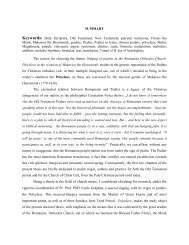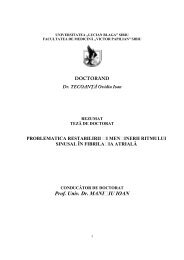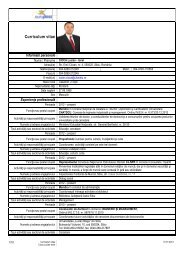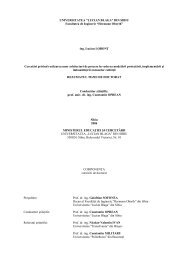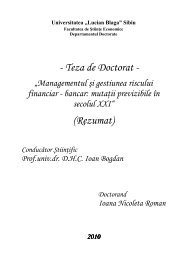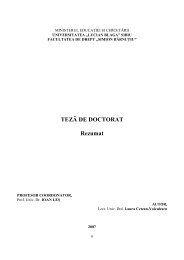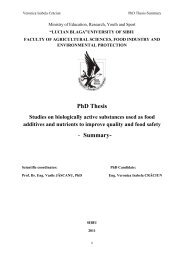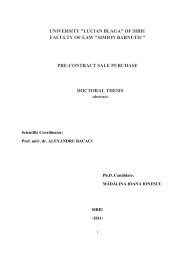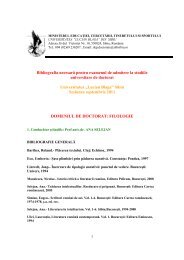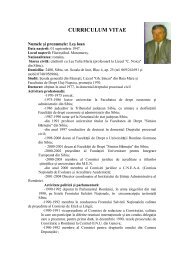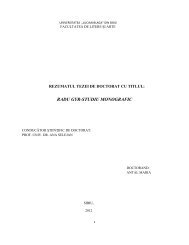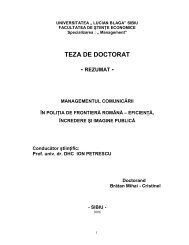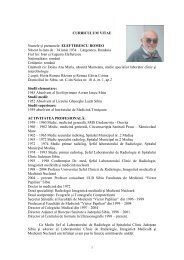Koppe 37 , that the relation focalizor – focalized is an intentional one, able to explainthe deep structure of the text. Even though the two researchers only concentrated oninternal focalization, regarded as the most complex, we have considered thatexten<strong>din</strong>g the remark over the other types of focalization would benefit the analysis ofnarratives in general. This is because the semantic structure of the literary work, itsmessage, is the result of the abstract author’s intention, who does not reproducereality, but represents it, operating a selection of facts and phenomena by means offocalization, a selection which should be given a sense.With Alexandru Ivasiuc, the essential conclusion is that his fiction is entirelyone of ideas, which aims at generalization. In our opinion, one needs to look for ideaseven beyond the situations depicted in novels which could be considered with a thesisat first sight, but which may reveal numerous elements which used to come againstthe political and ideological requirements of the time. In our analysis, we haveunderlined the recurrent themes in Ivasiuc’s fiction, which bring forward the realexistential, social and historical reality the author and his contemporaries lived: theabuses in the period of Gheorghiu-Dej, with trials, abusive imprisonments andexposures, the topic of political authority in the 1960s, with the typical opportunismand careerism, the presence of a repressive mechanism which annihilates individualityand subjectivity, the constant feeling of fear, the permanent self-control, the lack ofinternal freedom and the incapacity to communicate with the others. Given thepermanent restrictions imposed to literary themes at the time and the criticismstargeted towards any form of negativism and scepticism, the focalization on a side ofcommunism which should have been kept secret should be interpreted as a way ofdelegitimizing the official discourse, of imposing the perspective of an ideologywhich fought the official one.The last chapter of the thesis, Constructing Narrative Discourse, focuses onanalysing the temporal relations between events, as they could have happened in thereal world (history/ diegesis/ fabula) and the way they are presented in the story(story/ subject/ text). In the theoretical part of this chapter, we have made a synthesisof the terms used by the most important researchers in narratology with respect tohistory-order and story-order, stressing Genette’s contribution.37 Tobias Klauk, Tilmann Köppe, Discussion: Puzzles and Problems for the Theory of Focalization, inHühn, Peter et al. (eds.), The Living Handbook of Narratology, Hamburg: Hamburg University Press30
As regards order, the way events in the history are presented in the story, wehave referred to the types of anachronies (analepses and prolepses) Genette identifiedstarting, first of all, from the two essential elements characterizing them: the reach andthe extent. In point of reach, Genette distinguishes between three categories ofanachronies: external, internal and mixed, and in point of extent he identifies partialand complete analepses, whereas prolepses are, in his opinion, partial only. Inaddition, he mentions the distinction between “homodiegetic analepses” (which offerinformation on the characters and events which belong to the first narrative) and“heterodiegetic analepses” (which focus on other characters and events), as well asbetween completing and repeating anachronies.As regards the order, we have also referred to theoreticians who devisedclassifications starting from the definition of the narrative sequence. In this respect,Jean-Michel Adam and Francoise Revaz 38 offer an overview of the possiblecombinations between narrative sequences: alternating assemblage, embed<strong>din</strong>g -insertion, addition and the mixed type.From the point of view of the comparative analysis of the duration of events inthe fabula and the time allocated to their presentation in the story, Genette identifiescases of isochrony, which supposes the identity between the duration of history and ofthe story, and anisochronies, for which he introduces the notion of rhythm. Withinanisochronies, he identifies four basic forms of narrative movement: ellipsis,descriptive pause, scene and summary, to which he later adds the reflexive digression.The third issue related to the analysis of temporal relations between story andhistory, hardly investigated before Genette, regards frequency. Genette 39 defines it asthe relation between the number of times an event occurred in the diegesis and thenumber of times it occurs in the story, and he establishes the following forms: thesingulative narrative, with a sub-type (“narrating once what happened once” and“narrating n times what happened n times), the repetition (“narrating n times whathappened once”) and iteration (“narrating one time what happened n times”).In the subchapter entitled An order grounded in obsessional syllepses, we havehighlighted that Alexandru Ivasiuc’s first novels are characterized by a dissociationfrom the chronology in the history, triggered especially by the recall of the pastmoments. Given that the recollections always call for other recollections, the result is38 Jean-Michel Adam, Francoise Revaz, Analiza povestirii, Institutul European, Iaşi, 1999, pp. 80-81;39 Gérard Genette, Narrative Discourse..., p. 113;31
- Page 2 and 3: TABLE OF CONTENTSINTRODUCTION .....
- Page 4 and 5: SUMMARYThe doctoral thesis Narrativ
- Page 6 and 7: politics in Romania revealed the au
- Page 8 and 9: names began to emerge: Nicolae Breb
- Page 10 and 11: was awarded (two prizes of the Writ
- Page 12 and 13: with the text through the opinions
- Page 14 and 15: integrate elements involving both n
- Page 16 and 17: omniscience, from the discourse cha
- Page 18 and 19: “zero degree narratee”, any dev
- Page 20 and 21: the two main directions existing in
- Page 22 and 23: portrayal, but one based on signifi
- Page 24 and 25: What the characters discover after
- Page 26 and 27: The analysis on the character also
- Page 28 and 29: internal, the focalized can be perc
- Page 32 and 33: epresented by a proliferation of an
- Page 34 and 35: BIBLIOGRAPHYI. OPERA LUI ALEXANDRU
- Page 36 and 37: 6. Popescu-Neveanu, Paul, Dicţiona
- Page 39 and 40: 45. Neagu, Fănuş, Cartea cu priet
- Page 41 and 42: 21. Călinescu, George, Scriitori s
- Page 43 and 44: 60. Iser, Wolfgang, The Implied Rea
- Page 45 and 46: 98. Pârvulescu, Ioana, Prejudecă
- Page 47 and 48: 140. Selejan, Ana, Literatura româ
- Page 49 and 50: 14. Dimisianu, Gabriel, USR sau SSR
- Page 51 and 52: 3. Blandiana, Ana, Scriitorul şi P
- Page 53 and 54: 25. Pier, John, La narratologie all



